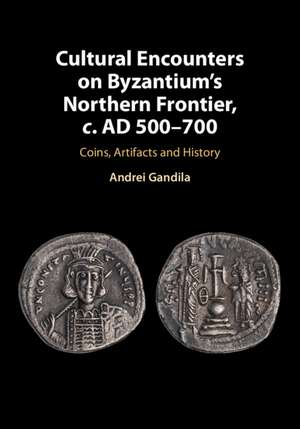Cultural Encounters on Byzantium's Northern Frontier, c. AD 500–700: Coins, Artifacts and History
Autor Andrei Gandilaen Limba Engleză Hardback – 24 oct 2018
| Toate formatele și edițiile | Preț | Express |
|---|---|---|
| Paperback (1) | 326.70 lei 6-8 săpt. | |
| Cambridge University Press – 18 aug 2021 | 326.70 lei 6-8 săpt. | |
| Hardback (1) | 805.22 lei 6-8 săpt. | |
| Cambridge University Press – 24 oct 2018 | 805.22 lei 6-8 săpt. |
Preț: 805.22 lei
Preț vechi: 936.31 lei
-14% Nou
Puncte Express: 1208
Preț estimativ în valută:
154.13€ • 167.47$ • 129.55£
154.13€ • 167.47$ • 129.55£
Carte tipărită la comandă
Livrare economică 21 aprilie-05 mai
Preluare comenzi: 021 569.72.76
Specificații
ISBN-13: 9781108470421
ISBN-10: 1108470424
Pagini: 394
Ilustrații: 69 b/w illus. 19 maps
Dimensiuni: 180 x 253 x 22 mm
Greutate: 0.95 kg
Editura: Cambridge University Press
Colecția Cambridge University Press
Locul publicării:Cambridge, United Kingdom
ISBN-10: 1108470424
Pagini: 394
Ilustrații: 69 b/w illus. 19 maps
Dimensiuni: 180 x 253 x 22 mm
Greutate: 0.95 kg
Editura: Cambridge University Press
Colecția Cambridge University Press
Locul publicării:Cambridge, United Kingdom
Cuprins
Introduction; 1. The Roman frontier in Late Antiquity; 2. Cultural diversity in the Danube region and beyond – an archaeological perspective; 3. Christianity north of the Danube; 4. Contact and separation on the Danube frontier; 5. The flow of Byzantine coins beyond the frontier; 6. Putting the Danube into perspective – money, bullion and prestige in Avaria and Transcaucasia; 7. Money and barbarians – same coins, different functions; Conclusions.
Recenzii
'The book’s brisk survey of imported pottery, oil lamps, and jewelry documents the broad appeal of Roman culture in northern barbaricum, and provides context for the intensive investigation of gold, silver, and bronze coinage. Excavated coins document contractual exchange among political elites as well as low-level social interactions, yet their popular reception remained as exotic objects rather than economic currency. Richly documented and closely argued, this book offers a fresh historical analysis of emerging cultural identities in the early Balkans. Recommended.' M. Rautman, Choice
‘Andrei Gandila has delivered a meticulously researched and presented book on a highly relevant and controversial topic … Gandila is already known to scholarship through a number of studies on early Byzantine coins. By making his findings relevant in a particular context, the book will deservedly introduce his research to new audiences.’ Julian Baker, Speculum
‘Gandila’s contribution to the study of frontier interactions is a welcomed addition to the study of late antiquity … This work is well written, easy to read and provides a solid platform from which further and more specific studies may be undertaken.’ David White, Journal of the Australian Early Medieval Association
‘… readers are ultimately rewarded with a richly detailed and impressive panorama of medieval history whose historical import is clearly manifest in Eastern Europe of the present.’ Michael J. Decker, American Historical Review
‘… Andrei Gandila’s monograph makes an impressive contribution to our understanding of the world they inhabited and the nature of their relations with the empire and the Lower Danube frontier. It should be essential reading for anyone studying diplomacy, frontiers and the history and archaeology of south-eastern Europe in the Early Byzantine / Early Medieval period.’ Alexander Sarantis, The Royal Numismatic Society
‘Andrei Gandila has delivered a meticulously researched and presented book on a highly relevant and controversial topic … Gandila is already known to scholarship through a number of studies on early Byzantine coins. By making his findings relevant in a particular context, the book will deservedly introduce his research to new audiences.’ Julian Baker, Speculum
‘Gandila’s contribution to the study of frontier interactions is a welcomed addition to the study of late antiquity … This work is well written, easy to read and provides a solid platform from which further and more specific studies may be undertaken.’ David White, Journal of the Australian Early Medieval Association
‘… readers are ultimately rewarded with a richly detailed and impressive panorama of medieval history whose historical import is clearly manifest in Eastern Europe of the present.’ Michael J. Decker, American Historical Review
‘… Andrei Gandila’s monograph makes an impressive contribution to our understanding of the world they inhabited and the nature of their relations with the empire and the Lower Danube frontier. It should be essential reading for anyone studying diplomacy, frontiers and the history and archaeology of south-eastern Europe in the Early Byzantine / Early Medieval period.’ Alexander Sarantis, The Royal Numismatic Society
Notă biografică
Descriere
Reinterpretation of the Danube frontier in Late Antiquity, drawing on literary, archaeological, and numismatic sources.
